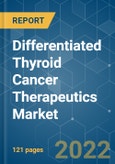The differentiated thyroid cancer (DTC) therapeutics market is expected to register a CAGR of 21.5% during the forecast period. The major factors attributing to the growth of the market are a rise in the incidence of papillary thyroid cancer, which is the most common type of thyroid cancer, accounting for about 80% of all cases. DTC typically doesn't cause any signs or symptoms early in the disease, which results in the development of lumps (nodule) on the neck area, causing difficulties in swallowing, and throat pain, and swollen lymph nodes in the neck.
According to the American Society of Clinical Oncology (ASCO), in 2019, approximately 14,260 men and 37,810 women in the United States were diagnosed with thyroid cancer. It is the most common cancer in women between 20 to 34 years of age, and women are more likely to develop thyroid cancer than men. Furthermore, a rise in government initiatives to control the healthcare burden and growing awareness regarding thyroid cancer treatment options are driving the DTC therapeutics market.
Key Market Trends
The Chemotherapy Segment is Expected to Hold a Major Market Share in the Differentiated Thyroid Cancer Therapeutics Market
- The chemotherapy segment holds a significant market share in the DTC therapeutics market over the forecast period. The dominance is owing to increased use of drugs like doxorubicin, cisplatin, and others as standard treatment. Huge demand can be attributed to the use of combinational drugs and their proven efficiency in preventing cancer progression. These combination drugs reduce the development of drug resistance, which is expected to fuel the market.
- On the other hand, targeted therapy is anticipated to grow at the highest CAGR. The lucrative growth is due to their usage when cancer is progressing. Also, these targeted drugs act differently on thyroid cancer than standard chemotherapy drugs. These agents block tumors from forming new blood vessels and target some of the proteins which increase the growth of cancer cells. The lesser side effects compared to chemotherapy is expected to boost the growth of the segment.
North America is Expected to Hold a Significant Share in the Market and it is Expected to do the Same in the Forecast Period
North America is expected to hold a major market share in the global differentiated thyroid cancer therapeutics market due to rising incidences of PTC, increased mortality rate in this region. For instance, the American Society of Clinical Oncology (ASCO), PTC covers more than 85% of overall thyroid cancers in the United States. Also, according to estimates published by the Thyroid Cancer Survivors' Association, thyroid cancer affects nearly 52,890 new cases in the United States in 2020, which increased from 52,070 cases in the year 2019. Furthermore, the presence of top pharma and biotech companies that are involved in the development of new therapies and the presence of well-established healthcare infrastructure is also fueling the growth of the overall regional market to a large extent.
Competitive Landscape
The differentiated thyroid cancer therapeutics market is moderately competitive and consists of several major players. In terms of market share, few of the major players are currently dominating the market. Some of the companies which are currently dominating the market are Bayer AG, Merck Co Inc., Jerome Stevens Pharmaceuticals Inc., Pfizer Inc., Curium SAS.
Additional Benefits:
- The market estimate (ME) sheet in Excel format
- 3 months of analyst support
This product will be delivered within 2 business days.








